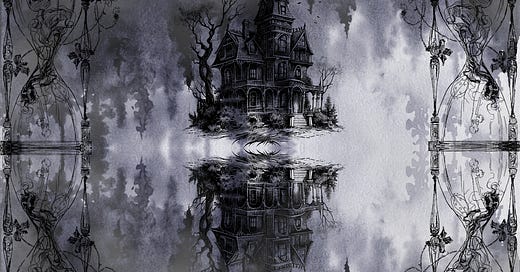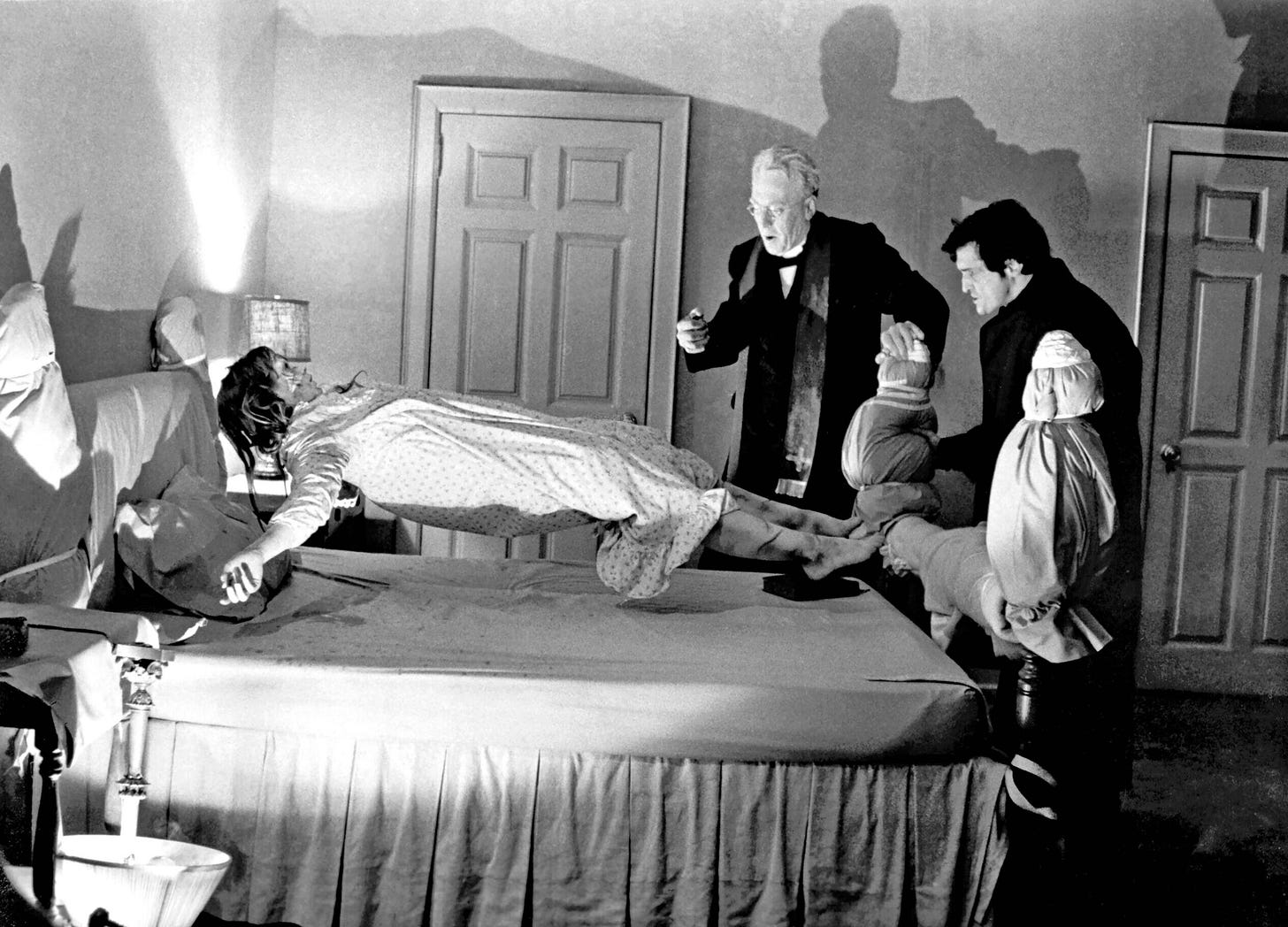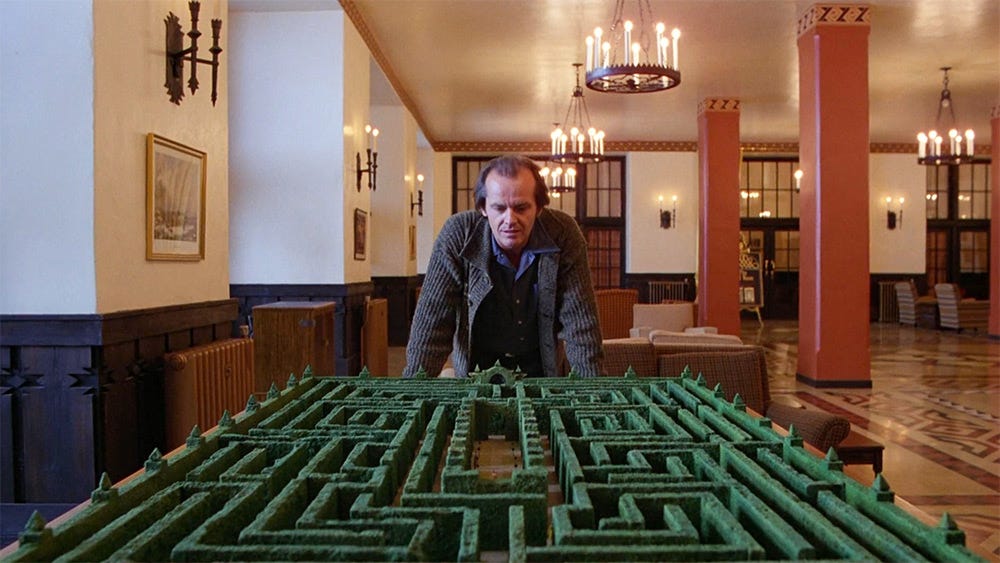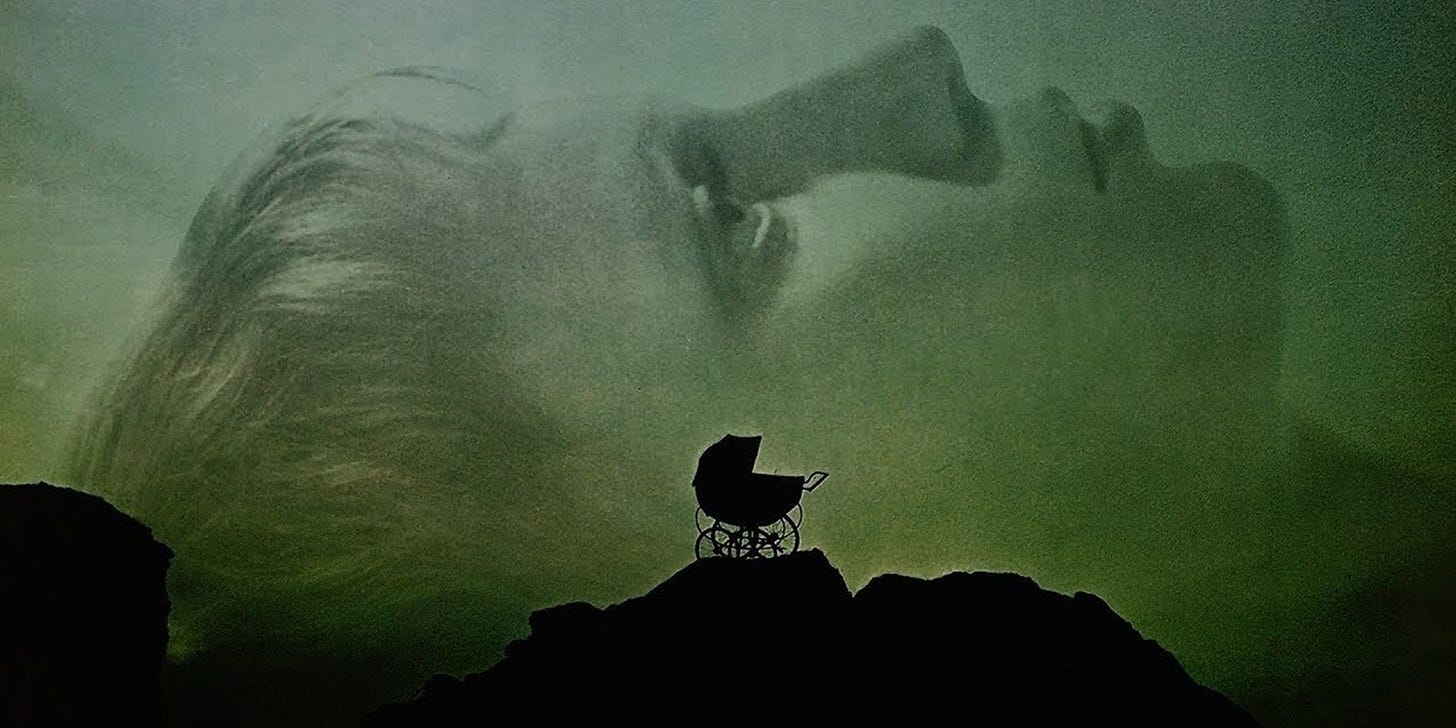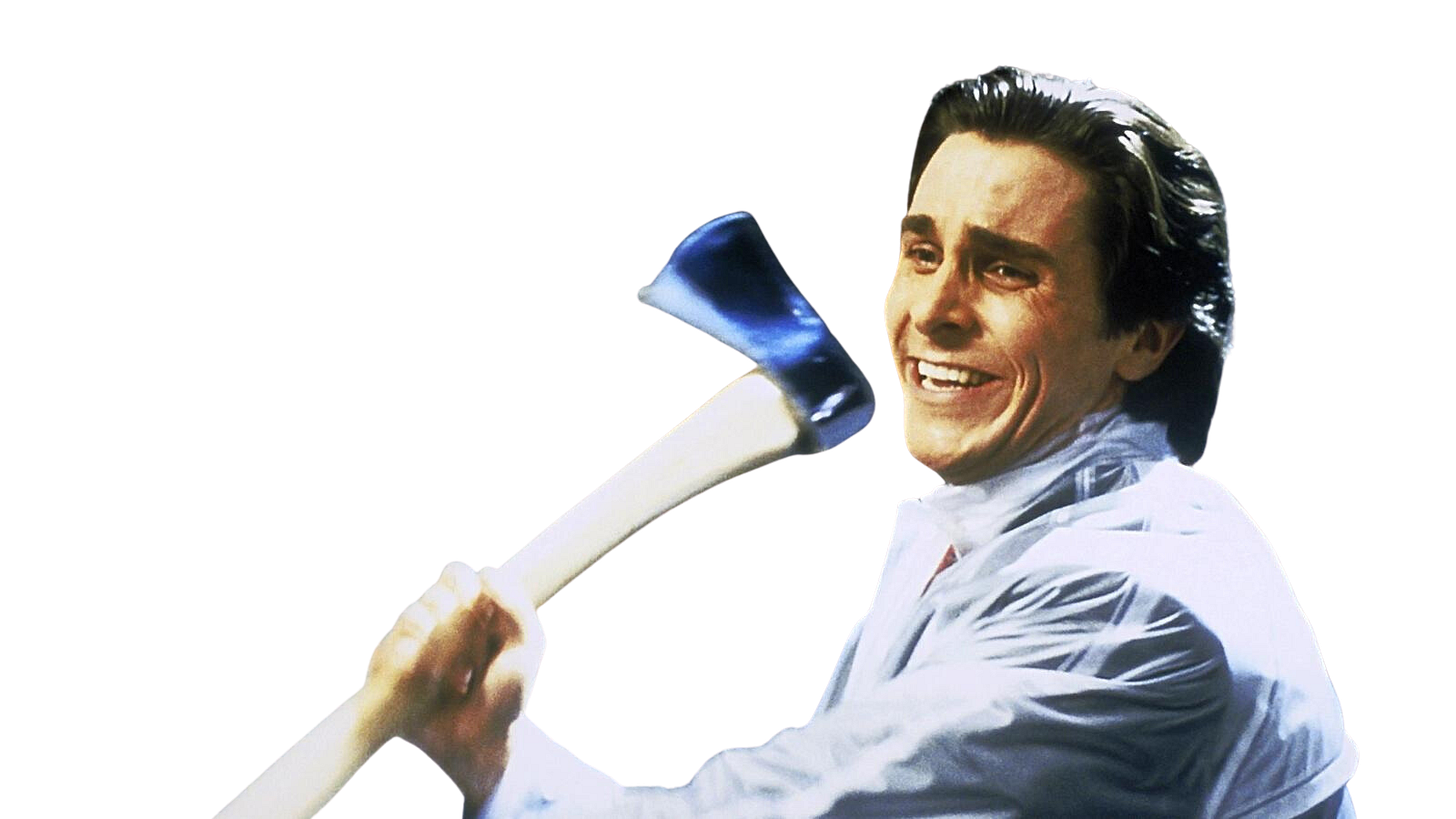At the ripe old age of 12 horror movies became my first “adult” hyper-fixation. My parents had a Netflix subscription early on in its existence as a mail-based rental service and I would take over the queue, bumping everyone else’s choices in favor of prioritizing iconic cult horror movies, Japanese horror movies, seventies slashers, and whatever other incredibly niche choices I could get my hands on. I remember late nights of watching the 100 Scariest Movie Moments on AMC alone in my room, writing down all of the obscure (to then young me) titles, later trying to find them on Netflix and cross-referencing on IMDB at the big, clunky gray Dell computer in the family room. I was so captivated by the genre, its depth, variety, and the experience of intentionally experiencing fear.
The horror genre largely eludes defining. Scholarly journal Wikipedia keeps it simple, starting its own entry on horror by defining it as, “a genre of fiction that is intended to disturb, frighten, or scare.” The entry goes on to add that horror intends to create an eerie and frightening atmosphere for the reader, and that “often the central menage of a work of horror fiction can be interpreted as a metaphor for larger fears of a society.” Another definition I appreciate comes from Noël Carrol in his book The Philosophy of Horror, “a story about an event or entity that contradicts our conventional understanding of the world.” Over time horror has become vast and sprawling, spawning dozens upon dozens of sub-genres, even reaching its tendrils out into other unsuspecting genres to instill fear in spaces we might not have previously seen it. Horror storytelling leans into tropes, uses certain storytelling devices to evoke specific responses of fear and feeling unsettled. Horror works at contradicting what we know or understand, it pits characters up against scenarios that aim to rattle their faith, shake their values, and make them question what they understand. Ultimately, as a genre, horror brings us into the underbelly of storytelling by pulling us into eerie metaphors that speak to our deepest fears , introduce us to uncanny and unsettling settings and characters, and speak to the parts of ourselves and society that are kept in the shadow.
So if horror is a genre of story telling meant to penetrate into our psyches to awaken the primal sense of fear, and astrology is a language meant to paint a picture of the innermost layers of our psyche, then where can we find the conceptual parallels between the storytelling that manifests through the art and practice of astrology and the fear-invoking genre of horror? If the birth chart presents us with a talisman that is all-encompassing of our human experience, then where does fear live within the birth chart?
While our natal charts certainly point towards our limitless potential and provide road maps towards constructing our best selves and best lives, on the other side of this exists a realm of shadow. An alternate dimension of our human experience that brings us down a dark and spooky road through our own fears: what we fear becoming, the fatal outcomes we fear await us (some unexpected and shocking, while others, like death and mortality, are simply inevitable), and the forces that have the ability to rob us of control and autonomy. Within every dimension and building block of astrology exists a spectrum between light and shadow. And within each realm of shadow exists a narrative that encapsulates what we fear, presents a potential reality that feels unsettling, or presents us with a darker part of ourselves or our reality that must be confronted. However, there are certain places within the natal chart that more innately invoke fear than others. There are certain places in the birth chart that provide us with inherent entry points into our deep psyche, that pull us into the depths of our own personal underworld, that speak to the experiences of death and mortality, and that have the potential to weave tales of terror when their shadow is not confronted and integrated.
The fourth, eighth, and twelfth houses are connected by grand trine within the structure of the chart, thus connected by element and tied together thematically. Treating the ascendant as the point of perspective, the line from which our vision stems, each of these houses structurally exists in places that are hidden. The eighth house sits just at the peripheral, existing in the distance, but unclear. The twelfth house is hidden from view, situated behind us and completely out of sight. The fourth house, the most subterranean point of the chart, is the least visible and most private place within a chart. Visually and thematically each of these places in the chart carry parallels in the stories they offer us. In addition to visually being situated in the “hidden” areas of the chart, each of these houses has thematic ties to things that are hidden and to the things that haunt us. Additionally, each of these houses carry delineations in Hellenistic texts of death and mortality, the ultimate fear that awaits us all. Within the depths of these houses, beneath the everyday significations that sit at the surface, dwell gateways into our personal underworld, the deep psyche, that bring us into contact with forces unseen.
the twelfth house
The twelfth house traditionally carries the name, the place of Bad Spirit, which is spooky enough in its own right. Its own meaning and significations can be evasive, especially in modern traditions, giving it an inherent factor of fear-inducing intimidation. Hellenistic texts designate this as the primary place associated with enemies, particularly hidden enemies, as well as loss and misfortune, suffering, ailments, injuries, dangers, weakness, death and troubles. The twelfth house carries spiritual connotations, connects us to the collective conscious, and also deals with themes of isolation. When considered through the axis it shares with the sixth house, the two places bring about the juxtaposition between the mystical and the mundane; between the interplay of the ordinary and the extraordinary, and in horror this pulls us into a narrative where unseen forces creep into our everyday life, where our spiritual and/or physical well-being is compromised by malignant forces, or through tales of being driven mad by literal or figurative isolation.
Stories of isolation, possession, and mental or spiritual disturbance pull us into the various facets of the horrors of the twelfth house. Twelfth house horror deals with hidden enemies (just as the twelfth house traditionally does), psychological horror, and even horrors that spread through the collective. Movies like The Ring, and It Follows feature protagonists up against invisible forces that are attempting to spread through society. Stories like The Exorcist and The Shining pull us down into the potential terrors of the twelfth house, showing us how they bleed into the sixth house of our everyday. In The Shining, we have Jack Torrence being driven mad by the unseen forces of the collective ghosts that haunt the Overlook hotel, where Jack and his family are isolated from support or connection with other people. The isolation of the Overlook and motifs like the hedge maze symbolize the terrors and perils of becoming trapped and lost within the labyrinth of one’s mind, as paralleled by the twelfth house themes of isolation, the subconscious, and mental unrest. In The Exorcist, Reagan is possessed by a team of demons, compromising her physical body and pushing her spirit into isolation within her own body, cutting her off from her mother and her life as she knows it. The Exorcist is ultimately a story of spiritual battle and crisis as Reagan’s physical form is taken over, and the accompanying spiritual crisis of Father Karras.
the eighth house
Most astrology enthusiasts will readily point to the eighth house as the spookiest place within the chart as it is. This house is traditionally considered the primary house associated with death, but it also concerns itself with the secondary consequences that follow death, such as inheritance. When we consider the psychological notions that accompany inheritance, we move beyond the idea of material gain and familial wealth (which often has its own dark origins), and into the realms of the emotional baggage thrust upon us. In its evolution through the modern lens, the eighth house has come to encompass the resources of others, dynamics of power, psychology, and inherently dark subject matter such as the occult. The eighth house shares an axis with the second house, the place of values, resources, personal possessions and wealth. In essence, the second house is everything that is ours outside of our physical self. It is what we cling to, it is our material realm, what we can depend on. Together as an axis, these two houses bring us into the juxtaposition between what we know and understand, what is ours, and those things that lurk beneath the surface, what is thrust upon us, and the values that are outside of our own, values that feel very unfamiliar (and possibly unsettling) to us.
Contextualizing these themes into horror storytelling, we are brought into scenarios where our own will and/or values are being tested by outside forces, scenarios where an individual finds themselves amidst a group whose ways and values are unfamiliar, and likely feel quite off or uncanny. The horror stories that bring us to the two-eight house axis force protagonists to navigate those unfamiliar values while either questioning or doubling down (or both) on their own values (think Midsommar or its predecessor The Wicker Man). These kinds of stories are prevalent in the folk horror genre, which incidentally, often deal with occult themes and “outsider” groups with pagan values. Another place in horror that brings us into the realms of the second and eighth houses are stories of haunted houses, where we see an individual or family confronting unseen forces that have come as an uninvited inheritance with an old house they have moved into. Confronting these forces puts the protagonists at odds with moral values or motivations that are imperceptible to their human selves, often forcing them to discern what is real vs. what is not real, or separate their own values from those that invisible forces are imposing upon them.
A beautifully rendered example of the latter style of horror exhibited by the second-eighth house axis is Mike Flanagan’s The Haunting of Hill House, which follows the lives of members of the Crain family as they confront, or succumb, to the emotional baggage inflicted on them as children by the titular haunted Hill House. The Hill House provides a setting with a mind, motivations, and values of its own, a house that is hungry to consume but with motivations and motives imperceptible to the Crains and other victims of Hill House. Rosemary’s Baby falls into this category from a different angle, providing a poignant example of a protagonist fighting to stand firm in her own values as she must discern what is real while being gaslit throughout her entire pregnancy by a group of occultist Satanic witches who have had her impregnated with the child of Satan.
the fourth house
Finally, we reach the fourth house. The fourth house brings us into the domain of the home, family, homelands, and lineage. At surface level this may seem like the most innocuous option of the three, but as the fourth house sits opposite the tenth, the most visible and public place of the chart, it represents things that are hidden and kept secret. While the twelfth house represents things hidden from us, and the eighth house contains things hidden beneath the surface, the fourth house represents those things that we keep hidden ourselves, that which we suppress. Combined with concepts of ancestry, the dark side of the fourth house tells stories of family curses, family secrets, and ancestral atrocities. Additionally, when we consider the axis of the fourth and tenth houses, we are looking at the representations of our public selves and ambition juxtaposed to our inner selves, the self we suppress, and the secrets we keep hidden. When looking at these juxtaposed houses through a horror lens, of course stories around generational trauma and family secrets come to mind, but also stories around the pursuit of ambition at the cost of parts of ourself that we suppress from the world.
Of course, when we think of horror based in generational trauma and family secrets, it’s impossible to not think of Ari Aster’s Hereditary. This movie’s plot revolves around dark family secrets being pushed to the surface as a dark entity torments an already grieving family. The main character, Annie (brilliantly portrayed by Toni Collette), struggles with her grief after the death of her secretive and estranged mother. After the tragic death of daughter Charlie just a few months later, the family’s already fragile dynamics begin crumbling as truths that have lurked beneath the surface for years begin pushing themselves back up again and as Annie finds herself tangled amidst unearthing the secrets of her mother.
Another example that leans more into the juxtaposition of suppressed self at odds with a public persona is found in American Psycho. Corporate ladder climber by day and serial killer by night, Patrick Bateman continually suppresses any sense of identity in favor of achievement and status in the corporate world. There’s a lot of interpretations of American Psycho out there, but whether you interpret Bateman’s killing spree as a fantasy that occurred in his mind or something that really happened that Bateman will never have to pay for, Bateman’s narrative is ultimately a story of sacrificing self in favor of a competitive yet conformist public image. Even if you want to zoom out from Bateman’s story and view the work as the capitalist critique it is, we’re looking at the collective abandonment of connection to our roots in favor of material consumer culture and the image of ourselves we craft for the public eye in pursuit of being “better than,” which illustrates the picture of pursuit and prioritization of the tenth house without a solid connection to the foundation of the fourth house.
Another perspective of the interplay between fourth and tenth houses manifesting in the horror genre can be seen in Robert Egger’s The Witch. The movie features protagonist, young Thomasin, dealing with the pressures of her responsibilities as the eldest daughter in a Puritan New England family. Here we see the burdens, resentment, blame, and toxicity that can bubble up within the sphere of the fourth house, [SPOILERS] but Thomasin ultimately (literally) ascends in pursuit of her own best interests and the promises of living deliciously, and joins a coven of witches. In this example we see the ascent towards the tenth house win over the pressures and troubles that plague the fourth house.


